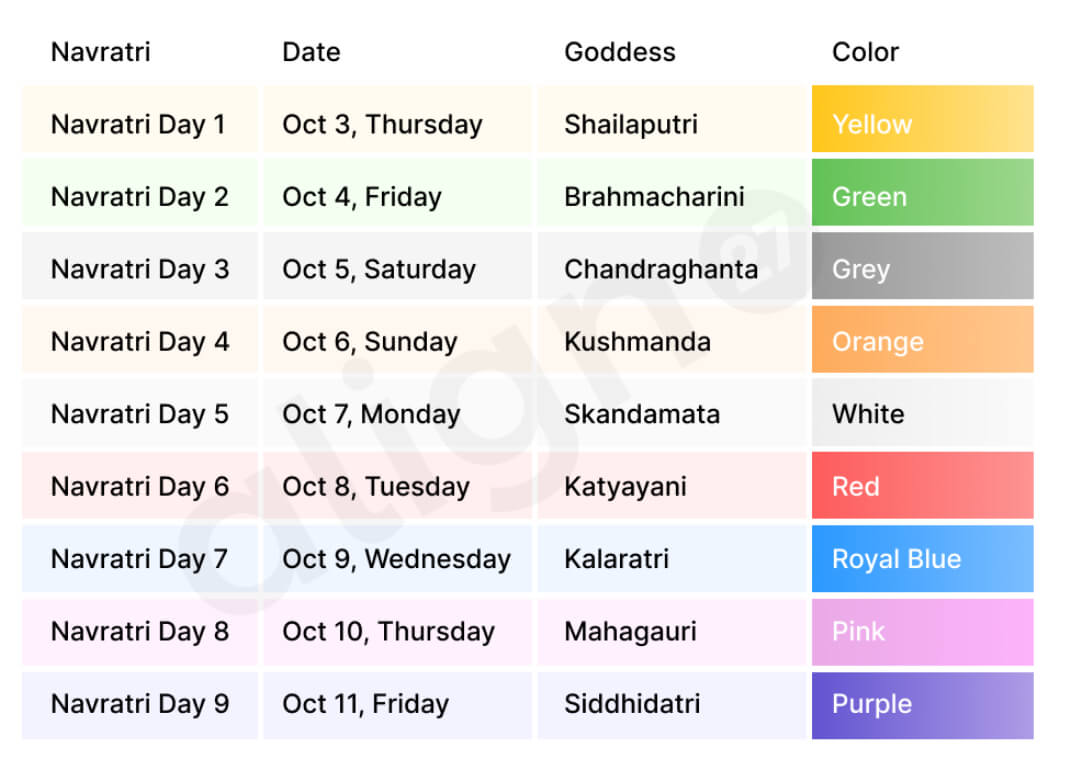Navaratri is a vibrant festival, celebrated over nine days in honor of the Goddess Durga and her various forms. Each day of Navaratri is associated with a particular color, and wearing these colors is believed to enhance the spiritual energy and connection to the divine. These colors symbolize different qualities and energies that the goddess embodies. Let’s explore the colors of Navaratri and the meanings behind them.

#### **Day 1: Yellow (Shailaputri)**
On the first day of Navaratri, the Goddess Shailaputri is worshipped. The color **yellow** is associated with this day, symbolizing brightness, joy, and happiness. Yellow also represents a new beginning, radiating positive energy and warmth as devotees embark on their spiritual journey.
#### **Day 2: Green (Brahmacharini)**
The second day is dedicated to Goddess Brahmacharini, the epitome of spiritual knowledge and penance. The color for this day is **green**, symbolizing growth, harmony, and fertility. Green is a reminder of nature and renewal, representing the new spiritual growth we experience through our devotion.
#### **Day 3: Grey (Chandraghanta)**
On the third day, Goddess Chandraghanta is worshipped. The color of the day is **grey**, representing balance, neutrality, and protection. It reflects the calmness and power of the goddess, who eliminates negativity and brings peace to her devotees. Grey also symbolizes transformation, which is central to spiritual progress.
#### **Day 4: Orange (Kushmanda)**
The fourth day is dedicated to Goddess Kushmanda, who is said to have created the universe with her divine smile. The color for this day is **orange**, representing energy, enthusiasm, and positivity. Orange reflects the power of creativity and the vibrant life force, inspiring devotees to pursue their spiritual path with passion and determination.
#### **Day 5: White (Skandamata)**
Goddess Skandamata, the mother of Kartikeya (Skanda), is worshipped on the fifth day. The color for this day is **white**, symbolizing purity, peace, and innocence. White embodies the serene and nurturing aspect of the goddess, representing the purity of a mother’s love and divine grace. Devotees seek peace and clarity by invoking her blessings.
#### **Day 6: Red (Katyayani)**
On the sixth day, Goddess Katyayani is honored, and the color of the day is **red**. Red represents strength, courage, and action. It is the color of power and intense energy, symbolizing the warrior aspect of the goddess. Red empowers devotees to overcome obstacles and fight injustice, invoking the fierce and protective energy of Katyayani.
#### **Day 7: Royal Blue (Kalaratri)**
The seventh day is dedicated to Goddess Kalaratri, the fierce and dark form of Durga, who destroys evil forces. The color for this day is **royal blue**, which symbolizes powerful energy, depth, and determination. It reflects the goddess’s strength in protecting the world from negative influences and ensuring justice prevails.
#### **Day 8: Pink (Mahagauri)**
On the eighth day, Goddess Mahagauri is worshipped. The color **pink** symbolizes hope, affection, and harmony. It represents the softer, compassionate aspect of the goddess, embodying beauty and tranquility. Pink invokes love, kindness, and devotion, helping devotees nurture a heart full of grace.
#### **Day 9: Purple (Siddhidatri)**
The ninth and final day of Navaratri is dedicated to Goddess Siddhidatri, who grants enlightenment and supernatural powers. The color for this day is **purple**, symbolizing ambition, spiritual wisdom, and royalty. Purple represents the divine knowledge and mystical powers of the goddess, guiding devotees toward higher consciousness and spiritual success.
### Conclusion
The colors of Navaratri not only enhance the festive spirit but also connect devotees with the deeper spiritual significance of each day. By wearing these colors, devotees align themselves with the qualities and energies of the goddesses they honor, fostering a deeper connection to the divine. Each color is a reminder of the goddess's power, protection, and grace, guiding us through our journey of devotion and spiritual growth.


0 Comments